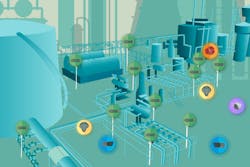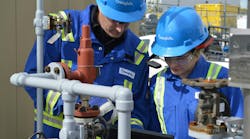Frequently industrial accidents occur because management and employees do not follow proper directions and precautions provided by their chemical or gas suppliers and plant equipment manufacturers. The typical root causes of industrial plant accidents include:
- Failure to follow specialty chemical and/or gas handling and storage instructions
- Failure to install and maintain equipment in which chemicals and gas could be present
- Failure to use portable and fixed gas and flame detectors
Detecting toxic and combustible gas leaks and fires can be a challenge under the best conditions at any plant. The problem is that, no matter how many fixed detectors are installed, a gas leak or fire can still go undetected if it does not contact a sensor or cannot be seen by a detector. The same is true of personnel wearing portable gas detectors. If they are not standing by a tank with a leaking valve, no one knows about the leak.
Today’s intelligent gas and flame safety detection systems are designed to eliminate human error through the layering of multiple gas and flame safety technologies to form a chain of defense providing increased coverage. These versatile detection technologies work together to form the human sensory model (HSM) (see Figure 1). The HSM mimics the senses of the people who developed them to increase immunity to false alarms, coverage and overall safety. For example, catalytic bead detectors "sniff" gases. Infrared (IR) optical type sensors "see" gases and unwanted fires, and ultrasonic sensors "hear" gases.
This article details a multilayer approach to gas and flame detection (see Figure 2) by reviewing 10 basic best practices for hazardous area safety.
Figure 1. The human sensory model (HSM)
Tip 1: Cultivate a "safety is job No. 1" culture
As obvious as it sounds, end users may be surprised at how often "Safety is job No. 1" is preached and not practiced. Managers must talk about safety seriously and continuously so that supervisors and employees understand this topic is not just lip service. Employee training is the first line of safety defense. When accidents occur, the U.S. Chemical Safety Board (CSB) investigates them, and management can learn a great deal about accident prevention from the CSB’s reports and video simulations.
Tip 2: Know industrial gas properties
The U.S. Occupational Health & Safety Industry (OSHA) publishes a free Chemical Hazard Communication booklet to help companies understand their responsibility to communicate with their employees about toxic gas, combustible gas and flame safety hazards and how to maintain a safe working environment. OSHA also requires the manufacturers of chemicals to provide safety data sheets, which explain the properties and hazards of chemicals and gases, along with their proper handling.
Tip 3: Review hazardous areas
Gas leaks and fires may originate from different sources within industrial plants, including leaking tanks, pipes, valves and pumps. Detecting dangerous gas leaks and fires reliably using any single conventional technology is a challenge for anyone. IR detectors, for example, cannot detect hydrogen gas because hydrogen does not absorb IR energy.
Another example is ultrasonic detectors. While a pressurized pipe gas leak may create an ultrasonic noise, so can other pieces of equipment, which can trigger ultrasonic gas leak detectors. Optical flame detectors can be fooled by reflections or heat rising from tanks and other shiny surfaces on hot days. Safety experts should review a plant for any potential safety issues and make recommendations for improvement at new and existing facilities.
Tip 4: Know how to operate portable gas detectors
Plant owners or managers cannot place a fixed gas detector everywhere personnel might work. In confined spaces, such as large tanks, the danger of toxic fumes or a lack of oxygen poses a hazard only when people are present. For this reason, portable gas detectors are designed with highly sensitive electrochemical cells that issue a warning display and sound alarms in the presence of specific gases, such as ammonia, chlorine, carbon dioxide or monoxide.
For these portable gas detectors to operate properly, they must be battery-charged, and personnel must know the length of time that they can be operated before recharging is required. After an alarm, employees must also know how to clean the portable detectors and when the sensing cells must be replaced.
Tip 5: Learn about combustible gas detectors
Multiple technologies and types of combustible gas detectors are suitable for use depending on the specific gas, plant equipment layout and plant operating environment. The operating principle of catalytic bead gas detectors employs catalytic combustion to measure combustible gases in the air at fine concentrations.
Point infrared (PIR) gas detectors use two wavelengths, one at the gas absorbing active wavelength and the other at a reference wavelength not absorbed by the gas. Neither wavelength is absorbed by other common atmospheric components such as water vapor, nitrogen, oxygen or carbon dioxide. With Open Path IR technology, the detection path of the IR beam is expanded from less than 10 centimeters, typical of PIR detectors, to greater than 100 meters.
In comparison to conventional gas detectors that measure the percentage of Lower Explosive Limit (LEL), advanced ultrasonic gas leak detectors with neural network technology (NNT) respond to the ultrasonic noise created by a pressurized gas leak, such as a leaky valve. Their NNT pattern recognition intelligence ignores false alarm sources, such as a nearby gas compressor in operation. They are best suited for outdoor installations and indoor spaces with high ventilation rates.
Tip 6: Learn about flame detectors
Several popular flame detection technologies are based on ultraviolet (UV) and IR sensing technologies. By combining a UV optical sensor with an IR sensor, a dual band flame UV/IR detector is developed with sensitivity to the UV and IR radiation emitted by a fire. The UV/IR flame detector offers increased immunity when compared to a UV-only detector and is suited for both indoor and outdoor use. Advanced multi-spectral IR flame detectors combine multiple IR sensors into a single sensor array using NNT intelligence. They provide pattern recognition capabilities that are based on training to distinguish real fires from normal events, such as reflected sunlight.
Tip 7: Review safety ratings
All gas and flame detectors are electrically powered. In the presence of gases, vapors and dust, they can be a source of combustion depending on their design, materials, construction and electrical safety ratings. To prevent accidents, global international organizations and regulatory bodies have devised multiple electrical safety rating systems according to their regional electrical codes.
The most common rating classifications for gas and flame detectors include but are not limited to Class 1/Div 2, CSA, ATEX and safety integrity level (SIL). In the U.S., the Class 1/Div 2 rating, for example, is an electrical design requirement for gas and flame detectors operating where combustible gas is present under abnormal conditions. Canada has a similar standard known as CSA. In Europe, the ATEX standard applies.
The SIL is a newer safeguard that measures the safety risk of an industrial process. Gas and flame detectors can be qualified to a safety instrumented system that places a protective layer of safety around a particular process.
Tip 8: Follow the manufacturer’s instructions
When working with specialty chemicals, gases, pumps and valves, safety equipment, or other equipment, the manufacturers of these items take great care to provide precise instructions for their use. The first rule of safety is: Do not deviate from the manufacturer’s instructions or improvise without first contacting the manufacturer and explaining the problem encountered at the plant.
Tip 9: Be vigilant about maintenance
All types of safety detectors require periodic maintenance. They also have a lifespan and require replacement. Well-maintained industrial plants achieve superior productivity at an overall lower cost. Short-term cost cutting on safety equipment maintenance can become expensive and have long-term, tragic consequences. The best practice is to be familiar with the recommended guidelines and when in doubt consult the technical team of each manufacturer.
Tip 10: Do not ignore alarms
Avoiding false alarms is also important because they result in unnecessary process or plant shutdowns requiring time-consuming reviews, paperwork and reporting. False alarms can, over time, provide employees with a false sense of security, and they may become complacent if alarms go off for no apparent reason and eventually ignore them. The trouble is that personnel alone cannot distinguish between a false alarm and a serious accident about to happen.
Figure 3. Next-generation detectors mimic the human brain to recognize and respond to patterns.
Today’s next-generation gas and flame detection systems apply artificial intelligence to increase false alarm immunity. They mimic the human brain’s ability to recognize patterns and respond accordingly (see Figure 3). For example, flame detectors with neural network intelligence can recognize and ignore reflected sunlight and the heat patterns emitted by storage tanks on sunny days that might have previously led to a flame alarm.
Conclusions
Adopting these 10 basic best practices for gas and fire safety may help save someone’s life because people continue to make mistakes. Never hesitate to ask for help with safety issues because being vigilant, thinking ahead and taking the right precautions can help achieve a multilayer chain of defense to protect people, equipment and the facility.
Ardem Antabian is OGP Segment manager for MSA-The Safety Company. He holds dual Bachelor of Science degrees in chemical engineering and chemistry. Joining the company in 1999, he has held various positions, including global assignments in Dubai and Berlin. He also helped develop the company’s advanced point and open path IR gas detectors and multispectral IR flame detector. He may be reached at [email protected]. For more information, visit www.msagasdetection.com.




